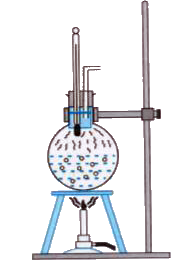What are vapourization and boiling point ? Explain the process of boiling of water. Solution in Gujrati
On heating, when the ice gets converted into water and as we continue further heating, we shall see that temperature begins to rise. The temperature keeps on rising till it reaches nearly 100 ∘C when it again becomes steady.
The heat supplied is now being utilised to change water from liquid state to vapour or gaseous state.
The change of state from liquid to vapour (or gas) is called vaporisation.
It is observed that the temperature remains constant until the entire amount of the liquid is converted into vapour.
Both the liquid and vapour states of the substance coexist in thermal equilibrium, during the change of state from liquid to vapour.
The temperature at which the liquid and the vapour states of the substance coexist is called its boiling point.
The process of boiling of water :

Take a round - bottom flask, more than half filled with water.
Keep it over a burner and fix a thermometer and steam outlet through the cork of the flask.
As water gets heated in the flask, note first that the air, which was dissolved in the water, will come as small bubbles.
Leter, bubbles of steam will form at the bottom but as they rise to the cooler water near the top, they condense and disappear.
Finally, as the temperature of the entire mass of the water reaches 100∘C, bubbles of steam reach the surface and boiling is said to occur.
The steam in the flask may not be visible but as it comes out of the flask, it condenses as tiny droplets of water, giving a foggy appearance.
If now the steam outlet is closed for a few seconds to increase the pressure in the flask, you will notice that boiling stops.
More heat would be required to raise the temperature (depending on the increase in pressure) before boiling begins again. Thus boiling point increases with increase in pressure.
Let us now remove the burner. Allow water to cool to about 80∘C. Remove the thermometer and steam outlet. Close the flask with the airtight cork.
Keep the flask turned upside down on the stand, Pour ice-cold water on the flask.
Water vapours in the flask condense reducing the pressure on the water surface inside the flask.
Water begins to boil again, now at a lower temperature. Thus boiling point decreases with decrease in pressure.
Topper's Solved these Questions
- BOOK - KUMAR PRAKASHANCHAPTER - THERMAL PROPERTIES OF MATTEREXERCISE - Try Yourself (VSQs)84videos
THERMAL PROPERTIES OF MATTER
- BOOK - KUMAR PRAKASHANCHAPTER - THERMAL PROPERTIES OF MATTEREXERCISE - Information : Higher Order Thinking Skills (HOTS)8videos
THERMAL PROPERTIES OF MATTER
- BOOK - KUMAR PRAKASHANCHAPTER - SYSTEMS OF PARTICLES AND ROTATIONAL MOTIONEXERCISE - SECTION-F (SECTION-D) QUESTIONS PAPER1videos
SYSTEMS OF PARTICLES AND ROTATIONAL MOTION
- BOOK - KUMAR PRAKASHANCHAPTER - THERMODYANMICS EXERCISE - Question Paper11videos
THERMODYANMICS
Similar Questions
''Amount of heat is greater in hot body than cold body''. Check correctness of this statement.
01:03View SolutionWhat is the triple point ?
01:44View SolutionA rope of negligible mass is wound round a hollow cylinder of mass 3 kg and radius 40 cm. What is the angular acceleration of the cylinder if the rope is pulled with a force of 30 N? What is the linear acceleration of the rope? Assume that there is no slipping.
View SolutionWhy is a steam burn more damaging than a burn with boiling water of the same ?
02:12View SolutionDefine 'boiling point' of a substance ? What is the boiling point of water ?
11:09View SolutionA liquid is converted into vapour below its boiling point . What is the process called ?
03:16View SolutionWhat is the density of water vapour at boiling point of water?
02:34View Solutionजल का क्वथनांक क्या है?
03:14View SolutionBoiling point of water is 373k then the boiling point of H_2S is
03:40View SolutionWhat is the value of normal boiling point and standard boiling point of water?
01:34View SolutionBoiling of water at its boiling point is an example of which process?
01:46View SolutionWhat is elevation in boiling point ? Explain.
02:02View SolutionBoiling point of water is 373k then the boiling point of H_2S is
03:23View SolutionWhat is the boiling point of water ?
03:13View Solutionजल का क्वथनांक क्या है ?
01:32View Solution

